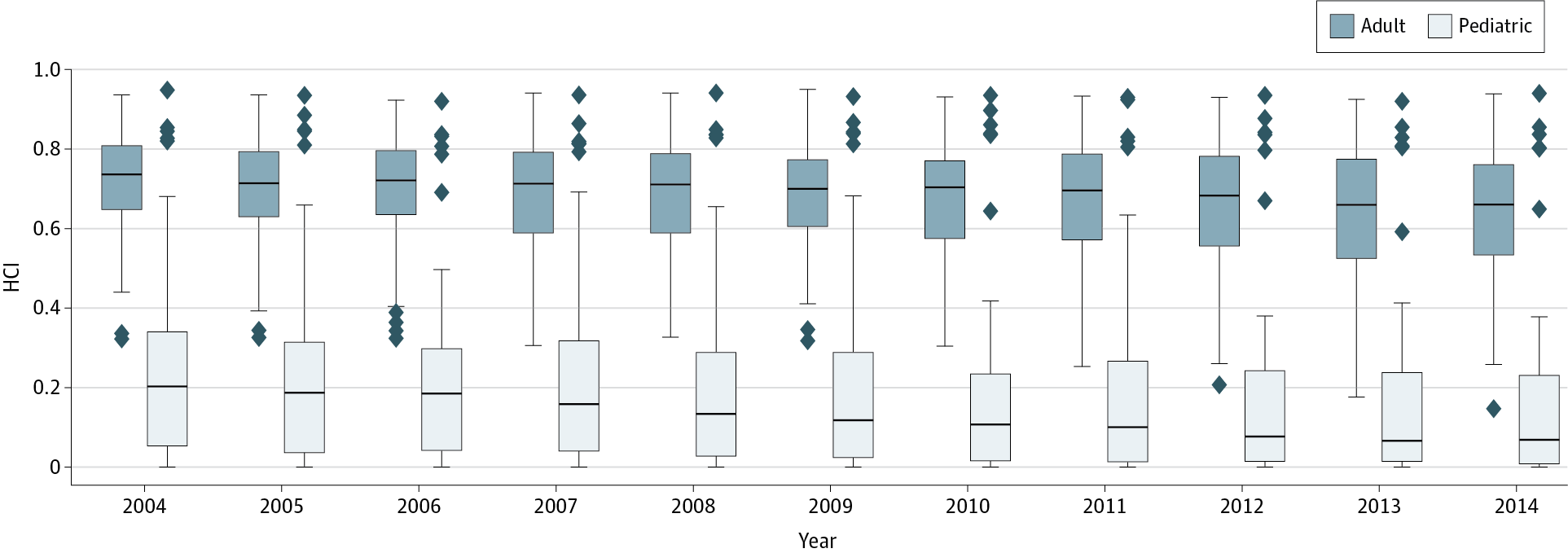当前位置:
X-MOL 学术
›
JAMA Pediatr.
›
论文详情
Our official English website, www.x-mol.net, welcomes your
feedback! (Note: you will need to create a separate account there.)
Availability of Definitive Hospital Care for Children
JAMA Pediatrics ( IF 24.7 ) Pub Date : 2017-09-05 , DOI: 10.1001/jamapediatrics.2017.1096 Urbano L. França 1 , Michael L. McManus 1
JAMA Pediatrics ( IF 24.7 ) Pub Date : 2017-09-05 , DOI: 10.1001/jamapediatrics.2017.1096 Urbano L. França 1 , Michael L. McManus 1
Affiliation

|
Importance Timely and efficient access to hospital care is essential for the health and well-being of children. As insurance networks, accountable care organizations, and alternative payment methods evolve, these new systems of care must continue to serve the needs of children. Objective To test the hypothesis that the availability of definitive pediatric hospital care is significantly more limited than adult care and is decreasing disproportionately. Design This study used case mix data during fiscal years 2004 through 2014 to measure transfer frequency and identify the site of care completion for all patients seen in acute care hospitals throughout Massachusetts. Patterns of care among children were then compared with patterns of care among adults. Participants were all patients seen in an emergency department or admitted to a hospital from 2004 through 2014, including more than 34 million encounters. Main Outcomes and Measures Hospital Capability Index and Regionalization Index for all acute care hospitals and all conditions within the Clinical Classifications Software of the Healthcare Cost and Utilization Project. Results Over the study period, the Commonwealth of Massachusetts hospital system was composed of 66 acute care hospitals. After excluding newborns and mental health conditions, there were 34 511 312 encounters, with 25 226 014 emergency department visits and 9 285 298 observation or full admissions. From 2004 through 2014, care for adults and children concentrated among hospitals but much more so for pediatric care. The number of children requiring care in more than one hospital increased 36.2% (from 7190 to 9793). The median (interquartile range [IQR]) Hospital Capability Index, reflecting the likelihood of a hospital completing a patient’s care without transfer, decreased 10.8% (from 0.74 [IQR, 0.65-0.81] to 0.66 [IQR, 0.53-0.76]) for adult care and 65.0% (0.20 [IQR, 0.05-0.34] to 0.07 [IQR, 0.01-0.23]) for pediatric care. Almost all of the shift was from nonacademic to academic hospitals. The median Regionalization Index, reflecting the degree to which care for specific conditions is regionalized, was very high for pediatric conditions and further increased from 0.79 (IQR, 0.67-0.91) to 0.87 (IQR, 0.80-0.91). Over the same decade, the mean Regionalization Index for adult conditions was low and increased modestly from 0.25 (IQR, 0.14-0.39) to 0.32 (IQR, 0.19-0.46). Among pediatric conditions, more than 75% were highly regionalized in 2014 compared with fewer than 50% in 2004. Conclusions and Relevance Pediatric hospital care has become increasingly concentrated, and many children with common conditions are now less frequently treated in the community. This finding has significant implications for systemwide capacity management and should be specifically accounted for in public health activities, disaster planning, and determinations of network adequacy.
中文翻译:

儿童最终医院护理的可用性
重要性 及时有效地获得医院护理对于儿童的健康和福祉至关重要。随着保险网络、负责任的护理组织和替代支付方式的发展,这些新的护理系统必须继续满足儿童的需求。目的 检验以下假设:确定的儿科医院护理的可用性明显比成人护理更有限,并且正在不成比例地减少。设计 本研究使用 2004 至 2014 财年的病例组合数据来衡量转移频率并确定在马萨诸塞州急诊医院就诊的所有患者的护理完成地点。然后将儿童的护理模式与成人的护理模式进行比较。参与者是 2004 年至 2014 年期间在急诊科就诊或住院的所有患者,包括超过 3400 万次就诊。主要结果和措施 医疗成本和利用项目的临床分类软件中所有急诊医院和所有条件的医院能力指数和区域化指数。结果 在研究期间,马萨诸塞州联邦医院系统由 66 家急症护理医院组成。排除新生儿和心理健康状况后,共就诊 34 511 312 人次,急诊就诊 25 226 014 人次,观察或完全入院 9 285 298 人次。从 2004 年到 2014 年,成人和儿童的护理集中在医院,但儿科护理更是如此。需要在一家以上医院护理的儿童人数增加了 36.2%(从 7190 人增加到 9793 人)。中位数(四分位距 [IQR])医院能力指数,反映了医院在没有转移的情况下完成患者护理的可能性,下降了 10.8%(从 0.74 [IQR, 0.65-0.81] 到 0.66 [IQR, 0.53-0.76])成人护理和 65.0%(0.20 [IQR,0.05-0.34] 至 0.07 [IQR,0.01-0.23])用于儿科护理。几乎所有的转变都是从非学术医院转向学术医院。区域化指数中值反映了对特定疾病的护理区域化程度,对于儿科疾病非常高,并从 0.79(IQR,0.67-0.91)进一步增加到 0.87(IQR,0.80-0.91)。在同一十年中,成人条件的平均区域化指数较低,并从 0.25(IQR,0.14-0.39)适度增加到 0.32(IQR,0. 19-0.46)。在儿科疾病中,2014 年有 75% 以上高度区域化,而 2004 年这一比例不到 50%。 结论和相关性 儿科医院护理日益集中,许多常见疾病的儿童现在在社区就诊的频率较低。这一发现对系统范围的容量管理具有重要意义,应在公共卫生活动、灾害规划和网络充分性的确定中得到具体考虑。
更新日期:2017-09-05
中文翻译:

儿童最终医院护理的可用性
重要性 及时有效地获得医院护理对于儿童的健康和福祉至关重要。随着保险网络、负责任的护理组织和替代支付方式的发展,这些新的护理系统必须继续满足儿童的需求。目的 检验以下假设:确定的儿科医院护理的可用性明显比成人护理更有限,并且正在不成比例地减少。设计 本研究使用 2004 至 2014 财年的病例组合数据来衡量转移频率并确定在马萨诸塞州急诊医院就诊的所有患者的护理完成地点。然后将儿童的护理模式与成人的护理模式进行比较。参与者是 2004 年至 2014 年期间在急诊科就诊或住院的所有患者,包括超过 3400 万次就诊。主要结果和措施 医疗成本和利用项目的临床分类软件中所有急诊医院和所有条件的医院能力指数和区域化指数。结果 在研究期间,马萨诸塞州联邦医院系统由 66 家急症护理医院组成。排除新生儿和心理健康状况后,共就诊 34 511 312 人次,急诊就诊 25 226 014 人次,观察或完全入院 9 285 298 人次。从 2004 年到 2014 年,成人和儿童的护理集中在医院,但儿科护理更是如此。需要在一家以上医院护理的儿童人数增加了 36.2%(从 7190 人增加到 9793 人)。中位数(四分位距 [IQR])医院能力指数,反映了医院在没有转移的情况下完成患者护理的可能性,下降了 10.8%(从 0.74 [IQR, 0.65-0.81] 到 0.66 [IQR, 0.53-0.76])成人护理和 65.0%(0.20 [IQR,0.05-0.34] 至 0.07 [IQR,0.01-0.23])用于儿科护理。几乎所有的转变都是从非学术医院转向学术医院。区域化指数中值反映了对特定疾病的护理区域化程度,对于儿科疾病非常高,并从 0.79(IQR,0.67-0.91)进一步增加到 0.87(IQR,0.80-0.91)。在同一十年中,成人条件的平均区域化指数较低,并从 0.25(IQR,0.14-0.39)适度增加到 0.32(IQR,0. 19-0.46)。在儿科疾病中,2014 年有 75% 以上高度区域化,而 2004 年这一比例不到 50%。 结论和相关性 儿科医院护理日益集中,许多常见疾病的儿童现在在社区就诊的频率较低。这一发现对系统范围的容量管理具有重要意义,应在公共卫生活动、灾害规划和网络充分性的确定中得到具体考虑。











































 京公网安备 11010802027423号
京公网安备 11010802027423号